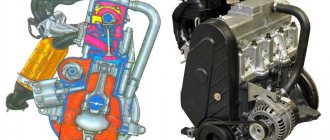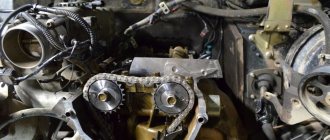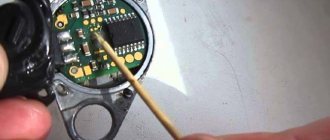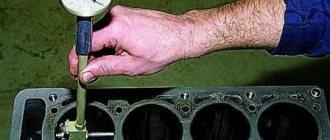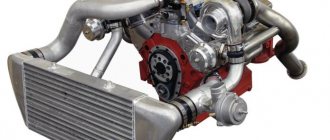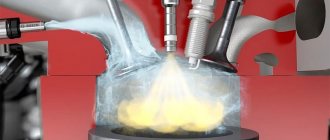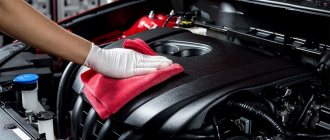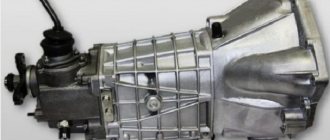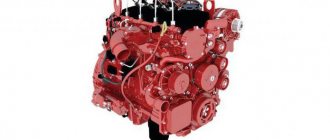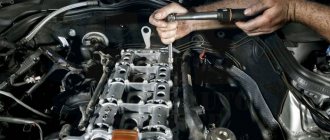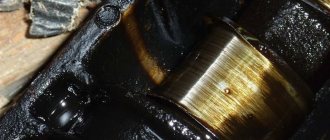Urban semi-korch
› Logbook › List of spare parts. For engine overhaul.
Hello. as I have promised )
1) head gasket - 35 2) valve cover gasket - 18 3) pan gasket - 18 4) valve kit. — 240 5) rings 80.0 — 120 6) oil removable caps — 40 7) chain tensioner — 80 pump — 130 9) pump pulley — 35 10) kit. gaskets - 7 11) oil pump - 170 12) fungus (niva) - 35 13) paint. blue, silver. 2 cans. — 65 14) sealant — 50 15) carburetor studs — 12 16) pig, belt bushing — 120 17) gasoline 5 liters, flushing — 50 18) clutch kit. — 520 19) oil filter — 30 20) crankshaft oil seal 2 pcs. — 55 21) fungus bushing — 15 22) crankshaft pulley — 65 23) crankshaft bearing — 30 24) flywheel boot — 40 25) crankshaft 0.25 used — 450 26) liners kit. — 80 27) half rings — 15 28) pistons kit. 80.0 E1 - 250 29) piston rings - 80 30) block boring - 260 31) pig boring - 60 total: 3,175
— 240 5) rings 80.0 — 120 6) oil removable caps — 40 7) chain tensioner — 80 pump — 130 9) pump pulley — 35 10) kit. gaskets - 7 11) oil pump - 170 12) fungus (niva) - 35 13) paint. blue, silver. 2 cans. — 65 14) sealant — 50 15) carburetor studs — 12 16) pig, belt bushing — 120 17) gasoline 5 liters, flushing — 50 18) clutch kit. — 520 19) oil filter — 30 20) crankshaft oil seal 2 pcs. — 55 21) fungus bushing — 15 22) crankshaft pulley — 65 23) crankshaft bearing — 30 24) flywheel boot — 40 25) crankshaft 0.25 used — 450 26) liners kit. — 80 27) half rings — 15 28) pistons kit. 80.0 E1 - 250 29) piston rings - 80 30) block boring - 260 31) pig boring - 60 total: 3,175
Engine overhaul is a type of repair when the main components of the power unit are comprehensively restored and/or replaced with new ones, which allows the power unit to return operational and resource indicators as close as possible to the factory ones. In other words, overhaul involves restoring the entire engine, and not just rebuilding its individual components.
It is worth considering that such repairs are an expensive professional operation and must be carried out using special equipment, taking into account strict adherence to a number of conditions. In this article we will talk about what kind of work is usually carried out during an engine overhaul, what is the service life of the engine after an overhaul, and also answer the question of what is better, a contract engine or an overhaul.
Read in this article
What is an engine overhaul, why and when do you need to do an engine overhaul?
Before moving on to what is needed for an engine overhaul, you need to know when and for what reasons the specified overhaul of a diesel or gasoline engine is done. Let's start with the fact that a major overhaul of the power unit includes disassembling the internal combustion engine, cleaning the propulsion system, assessing the condition, checking and troubleshooting all components. Next, the worn elements are replaced and/or repaired, depending on the degree of wear, severity of damage, etc. In some cases, the crankshaft is grinded, the cylinder block is bored or lined, work is done on the channels of the lubrication and cooling systems, the crankshaft is repaired, etc. In other cases, any operations can be avoided.
At the same time, you need to know that a “capital” is significantly different from an engine overhaul. A refurbishment usually refers to the replacement or repair of a specific failed element. More often the situation is emergency, for example, burnout of a piston or valve, scuffing in the cylinder, etc. Engine overhaul is usually done if the engine has already worn out to such an extent that its further normal operation becomes impossible or becomes very difficult without comprehensive repair and restoration work. Critical engine wear is determined by low compression in the cylinders, loss of power, increased oil and fuel consumption, smoke, and unstable operation of the internal combustion engine in different operating modes.
What is the mileage before engine overhaul?
Each manufacturer sets a certain resource for the unit before major repairs. On average, the figure is about 150-200 thousand km. mileage The specified overhaul of a car engine is applied to modern vehicles, which are often equipped with low-volume or medium-volume highly accelerated power units.
It should also be noted that the indicated figure is greatly influenced by the quality of service, fuels and lubricants, fuel, individual operating characteristics, problems that arise and the timeliness of their elimination. In other words, the life of the motor can be either significantly increased or significantly reduced, and this depends on the maintenance and the driver himself.
This statement is quite fair; there are many examples to prove it. In practice, the same engine can run 80-100 thousand km, after which it needs an expensive “overhaul”, while another will cover 250-350 thousand km, after which in some cases not a major overhaul is done, but only surface bulkhead. Let us add that if the engine is working normally and there are no obvious reasons for disassembling it, then the unit can be safely operated, and without reference to specific numbers.
Major renovation
There are two types of major repairs - planned and unplanned. With a mileage of more than two hundred thousand and the natural aging of the car, you should expect that sooner or later the engine will start to malfunction. An attentive owner, based on several indirect signs, is able to determine that it is time to prepare for a major overhaul. The first symptoms of a “sick” engine:
- Increased oil consumption, which indicates wear of the piston rings or valve guides.
- Characteristic blue exhaust.
- Sluggish acceleration, which indicates a decrease in compression in the cylinders.
- Significant drop in power and traction characteristics.
- Characteristic knocking noises in the cylinder block or cylinder head.
Scheduled repairs include replacing valve stem seals, grinding valves, adjusting the gap, replacing oil scraper and compression rings, as well as grooving the crankshaft and changing the main and connecting rod bearings. Such actions are advisable provided that there is hon on the walls and there is no exhaust. This is a gentle repair that costs less money and time and does not require replacement of large components.
It allows you to extend the life of the motor by several hundred thousand kilometers, depending on the operating conditions and the fluids used. In this case, there is no question of what is better: a major overhaul or a contract engine. Definitely just a renovation.
Unscheduled repairs are usually required when the driver does not monitor the condition of his car or delays paying the planned capital while continuing to drive the car. Reasons for failure:
- Poor quality oil and fuel.
- Untimely oil change.
- Water hammer (liquid in the combustion chamber)
- Engine overheating.
- Timing belt rupture.
Any of these reasons entails disassembling the engine, overhauling it and installing new parts. Often one of them starts the entire chain reaction and several spare parts gradually or immediately fail.
During a major overhaul, all consumables must also be replaced, such as: connecting rod and main bearings, piston rings, and, if necessary, the cylinders themselves. This is done in order to avoid repeated disassembly. You should also replace all spare parts that are in doubt.
In some cases, it may be necessary to bore the cylinder block, grind the crankshaft, or grind the valves. All this results in additional financial expenses. If we consider, on average, the cost of repairs and necessary spare parts is equal to the price of a contract engine including labor (sometimes several thousand more).
Another equally important point in this whole undertaking is to find a good specialist who will not screw up the purchased spare parts and the old engine, but will do everything as it should. At the same time, he should understand the quality of the ordered parts and, if possible, make a small discount (a dream).
If your hands grow out of place, then you can try to repair the motor yourself. Buying parts is not a problem now, especially since almost every city has its own trusted suppliers. Do-it-yourself engine overhaul also has several disadvantages:
- Additional equipment (winch, tools, torque wrench).
- Ordering spare parts. Entering the VIN number incorrectly can result in an inappropriate part appearing in the garage.
- Duration. Typically, repairs are carried out during free time and can take a long time.
- There will be no one to blame for poor quality repairs.
But there is one significant advantage - you don’t need to pay for the work, and this allows you to significantly save on major repairs. In addition, the car enthusiast knows exactly what he replaced, what part he installed, and how the work was done.
In general, if the capital is made with high quality, original spare parts are installed, everything is lubricated and adjusted, then the driver receives a new engine capable of running the same amount. At the same time, the car’s engine remains “native” and does not bring with it any additional “surprises”.
Engine maintenance after a major overhaul and running in the repaired engine
It is worth noting that after a professional overhaul and if a number of conditions are met, the engine can go through the same amount, and sometimes even more, than it did after leaving the factory. This is especially true of high-tech turbo engines that run on low-quality domestic fuel.
The widespread use of nicosil, alusil and similar alloys for casting BCs, according to experts, is the reason that new internal combustion engines on reputable foreign cars can fail in the CIS after 70-80 thousand km. mileage To solve this problem, today the method of lining the cylinder block is used, which allows the unit to operate normally and theoretically surpass the original design in terms of the service life of the block and the engine itself in such conditions.
Also, one of the most important criteria is the correct running-in of the engine after a major overhaul. The requirements for such a run-in are similar to those put forward for running in the engine of a new car from the passenger compartment:
- short-term warm-up before the trip;
- gentle operation without sudden accelerations and stops;
- speed restrictions, prohibition on driving “tightly” in high gear;
- Engine braking is not allowed;
- prolonged movement at a constant speed at the same speed is prohibited;
- It is not permitted to tow a trailer or transport goods, etc.
Tips and tricks
As already mentioned, the service life of an internal combustion engine before overhaul depends on many factors. In order to delay major engine repairs, it is necessary to pay special attention to the quality and correct selection of engine oil in relation to a specific type of engine, and promptly change the air, oil and fuel filters. Also, the power unit must be able to operate correctly, avoiding constant peak loads and tight driving. It is equally important to monitor the condition of the engine, quickly eliminate problems that arise, and carry out preventive procedures.
- The main reason for rapid engine failure is oil changes, which are not carried out according to regulations. Increasing the replacement interval, taking into account the low quality of fuel and dusty roads in the CIS, leads to the fact that the engine ultimately runs on lubricant that has oxidized and lost its properties. Dust and deposits also enter the unit through clogged filters. As a result, the associated rubbing parts begin to work under conditions of increased wear, the channels of the lubrication system become coked, the power system suffers, etc.
What is an engine overhaul?
Engine overhaul involves disassembling, troubleshooting and replacing parts of the power unit whose technical characteristics do not meet the required standards. As a result of these actions, it is possible to bring the performance characteristics of the internal combustion engine as close as possible to those that it had in a new state.
During the overhaul process, all engine components and associated units are updated as much as possible, taking into account the appropriate tolerances. Major repairs must be carried out to the minimum possible tolerances, which will ensure the required safety margin of the parts. The maximum tolerance indicates that the part can still be used, but this period is very limited. Considering that most parts in the motor experience high loads and friction, the maximum tolerance cannot be applied to them.
Engine overhaul is a whole range of procedures that involve servicing not only the structural elements of the engine, but also the systems and components associated with it. For example, you cannot replace only the piston rings and get the desired effect. At first it will manifest itself in the form of increased power and reduced oil consumption, but this will not last long. The task of a major overhaul is to return the engine to its previous performance as much as possible, which will remain for 100-200 thousand kilometers. If the engine after overhaul can only travel 20-25 thousand kilometers, then such repairs were carried out in vain and a new one will be required, made in accordance with all requirements and tolerances.
Let's consider what procedures include a major overhaul of an internal combustion engine.
Removing the motor
Before overhauling the power unit, it is removed from the machine. Next, the integrity of its components is inspected, followed by disassembly and troubleshooting of all parts.
Adjusting valve clearances
If the engine is not equipped with a hydraulic compensator, valve clearance must be adjusted every 60-80 thousand kilometers. If this is not done in time, the backlash will increase, which will lead to knocking noises in the engine and wear of its valves.
Piston group repair
The dynamic characteristics of the engine largely depend on the condition of the piston group. The need for its repair can be judged by such a parameter as compression. Compression measurement allows you to obtain information about the pressure in the engine cylinders. Based on these data, a decision is made on the need to repair the piston group.
Replacing crankshaft seals
To extend the life of the engine, it is important to promptly change the front crankshaft oil seals. Replacement is carried out even if there is no visible damage on them. If traces of oil leakage have already appeared, this may indicate the need for major repairs.
The rear seals bear most of the load, so their timely replacement is also very important. If the seals leak or are starved of oil, they should be replaced as soon as possible.
Replacing camshaft seals
These seals prevent oil from leaking into the crankcase. When servicing the gas distribution mechanism or camshaft, the condition of the seals must be checked. If they leak, be sure to replace them with new ones.
Replacing valve stem seals
These elements allow you to control the amount of oil used to lubricate rubbing parts. If they lose their elasticity and become unusable, an excess supply of oil occurs and its consumption increases.
Replacing the cylinder block gasket
The failure of this element is indicated by the presence of light smoke from the exhaust pipe, the appearance of bubbles and impurities in the coolant.
Replacing the oxygen sensor
The lambda probe controls the formation of the air-fuel mixture. If there are problems with this sensor, fuel consumption increases and the life of the spark plugs decreases.
Pump repair or replacement
The pump circulates coolant inside the engine. If its operation is unstable, the antifreeze will be worse at removing heat from the engine, which will begin to overheat.
What's the result?
As you can see, maintaining all systems in good condition and timely maintenance using high-quality consumables and fuels and lubricants can significantly extend the service life of the power unit before major repairs. But that's not all. The engine operating mode deserves special attention. The degree of wear and tear depends on how the owner drives his car. An aggressive driving style and frequent maximum loads can reduce engine life by 40-50%. We are talking about intense acceleration with the crankshaft spinning up to maximum speed (cut-off), as well as prolonged driving at speeds close to maximum. The service life of the internal combustion engine is also significantly reduced when the driver heavily loads a cold engine without preheating, that is, before the unit reaches operating temperatures. Such actions can damage the engine by 40-50 thousand mileage.
In other words, pre-warming, a moderate driving style and knowledge of what speeds are best to drive at can extend the life of the engine to its full potential. Timely gear shifting on models with manual transmission makes it possible to avoid tight driving, which is very dangerous for the crankshaft and the entire engine.
Taking into account the above, for experienced and responsible drivers, the engine can go much further than the figure that the manufacturer itself defines as the average threshold before the first major overhaul. This is confirmed by many examples of the internal combustion engine of a modern foreign car with a service life of 200-250 thousand km. with proper maintenance and proper operation, it lasted up to 300-350 thousand kilometers or more.
Today we will tell you what an engine overhaul is and when it is necessary. What is included in the capital and what spare parts and tools are needed.
Overhaul of a car engine is a list of works associated with disassembling, troubleshooting the internal combustion engine, replacing individual elements and processing (honing, grinding, straightening, etc.) of some of its surfaces and parts in order to bring the characteristics of the engine to the values that a new unit has. Those. Metalworking operations are necessarily carried out under capital conditions. If you simply replace the rings, it will not be a major overhaul.
The material was prepared by specialists from the website Skrutit-speedometr.ru.
When is engine overhaul necessary?
There is no point in focusing on any specific mileage figures in this matter. After all, a lot depends on the operating conditions of the car, compliance with the manufacturer’s recommendations for maintenance, the quality of fuels and lubricants and many other factors.
The moment when it becomes necessary to overhaul the engine must be determined by its characteristic features. They may be the following:
- Increased oil consumption. If after 1000 km the car “eats” it to the min mark, there is a reason to carry out diagnostics.
- White thick (just make sure it's not steam) or blue smoke from the exhaust pipe.
- The appearance of uncharacteristic sounds when the engine is running (in most cases these are dull and metallic knocks).
- The presence of “terry soot” on the candles.
- Reduced compression in one or more cylinders.
- Significant increase in fuel consumption.
- Damage to the gasket (often this causes coolant to actively leak out).
- Uneven operation of the internal combustion engine (if the problem cannot be corrected by adjustments, flashing the computer, replacing spark plugs and other operations).
What equipment and what spare parts are needed for engine overhaul
Let's start with spare parts. BUT BEFORE YOU NEED TO UNDERSTAND that their list, depending on the design of the motor and the nature of the damage, may change. It is better to clarify this with specialists.
When overhauling an engine, as a rule, the following is required:
- Set of pistons and rings.
- Spark plug.
- Sleeves (if remitted using the sleeve method).
- A set of valves and guides for them.
- Main and connecting rod bearings.
- Seal kit.
- Filters: air and oil.
- Engine coolant and oil.
- Belt (timing chain) and drive of attachments.
- Gasket set.
- Oil pump and cooling system pump (if necessary).
- Special alloy tape.
As for the equipment, you will need a set of wrenches and screwdrivers (it is different for each engine). Moreover, to tighten most connections, the wrenches must be torque wrenches, because the highest precision is required here. You also need a special measuring tool, a set of pullers (depending on the engine, their composition varies), electric hoists, support frames and stands, tools for repairing and restoring threads, etc.
If you need to hone surfaces or straighten camshafts, you will need the appropriate tool. If there is a need to search for microcracks or cracks on the crankshaft, you will need a magnetic flaw detection device. In some cases, a welding machine will also be required (its type is selected based on the materials from which the motor is made).
It can be seen that not all the tools can be found in an ordinary garage. Therefore, in most cases it is impossible to carry out capital financing in “makeshift” conditions.
What spare parts are needed
Consider the list of spare parts for major repairs of the power unit:
- Piston group kit, it includes pistons, piston rings, piston pin. If the block is sleeved or such a need arises, then sleeves are purchased accordingly. When purchasing a piston group, there is no need to rush; you must first take the block to where you are going to sharpen it, and only after measuring the master will tell you what type of repair the piston needs to be purchased.
- It's a matter of desire; if you want, you can purchase pistons with recesses, especially useful if you are experimenting with split gears, etc. And the chain, despite its reliability, can break once every 20 years and then the meeting of the pistons with the valves is inevitable.
- Main and connecting rod bearings are purchased after the crankshaft has been ground. After grinding the crankshaft, the master will tell you which bearings you need to buy - 0.25, 0.50, 0.75, 1. This depends on the degree of wear of the crankshaft. It is better to take original earbuds.
- Oil pump. This matter is quite controversial, but I prefer to change it when conducting capital. Many people say that it can last for a very long time - I don’t take into account such stories, do it like that.
- Camshaft I also recommend replacing it, but if finances are really bad, you can postpone replacing it, but this is not very advisable. Although if the camshaft is in good condition, you can leave it.
- The intermediate shaft (drive shaft of auxiliary units, pig) is the shaft that rotates the distributor and the oil pump and is driven by a motor chain. This shaft greatly affects the pressure in the lubrication system - if the bushings are heavily worn, the oil pressure drops significantly. When overhauling an engine, the bushings must be replaced, processed with reamers, and the shaft is also either ground or replaced with a new one. There is also an intermediate shaft on ball bearings; this, in addition to increasing the service life of the industrial shaft, also allows you to increase the pressure in the lubrication system. From all this, it is necessary to take away that at the time of sending the block for grooving, you need to purchase a new one or take with you an old washer so that you can replace the bushings and grind the shaft (if you leave the old one), at least this is the case with us.
- If the cylinder head is also being repaired, then it is necessary to purchase valves, valve seals, and springs (if the old ones do not hold the force).
- I also recommend replacing the entire motor chain tensioning system, as well as the motor chain itself, this includes: crankshaft, camshaft, shaft sprockets, motor chain, motor chain tensioner shoe, motor chain tensioner, motor chain damper. Beware of fakes, there have been cases when the motor chain tensioner shoe was made of non-oil resistant rubber and it collapsed quite quickly. I try to install a plastic damper, since even if it breaks, it may not harm the engine as much as a rubber-metal one.
- The crankshaft seals, rear and front, must be replaced.
- You also need to purchase a set of gaskets, you can buy all paper gaskets separately, and buy them separately for the pan, valve cover and under the cylinder head.
- Also check the bearing, which includes the gearbox input shaft, at the end of the crankshaft. If there is play in the bearing, it must be replaced.
- If the engine knocks or the connecting rod bearing turns, then the connecting rod must be replaced.
- Also, do not forget about all the consumables - oil, filter, coolant.
What is included in an engine overhaul and how is it performed?
REMEMBER , depending on the type and design features of the motor, as well as the nature of the damage, the list of work may vary. Moreover, before repairing the internal combustion engine, it is necessary to thoroughly wash it so that all contaminants are removed from the oil-conducting channels. You can, of course, do this yourself, but it is better if you use specialized equipment (for example, an automatic washing unit AM1150).
If we consider the process of engine overhaul in general, it includes the following operations:
- Cylinder block repair. Cracks and other small damage may appear in this element. They can often be eliminated by welding. And this applies to blocks made of aluminum and cast iron. To detect cracks, you will need a pressing bath (if you are doing the repairs yourself, then there can be any suitable container of appropriate size so that the part can be completely immersed in water) or a special installation for hydraulic testing
- Boring or sleeve block. IMPORTANT. Not every engine can be repaired by boring. It all depends on whether the developers include repair dimensions in it or not. If there are liners in the cylinders from the factory, they are pressed in and replaced with new ones. ICEs with aluminum blocks are usually repaired by lining.
- Repair of the crankshaft and its beds. If there is damage on the necks, they can be removed by grinding. If there is a need for editing, this is done using a special press. In case of severe wear of the journals, fragments of a special alloy tape may be welded onto them.
- Repair of valve seats. As a rule, after this they will need to be ground in. But if you repair using professional equipment (for example, from SERDI), this need disappears.
- Repair of microcracks by welding and grinding.
- Replacement of footers and studs.
Stages of engine repair
Rebuilding the engine involves performing the following actions:
- Removing the motor.
- Complete disassembly and removal of accumulated dirt by washing and cleaning.
- Identification of defective spare parts of the block that need to be replaced: inspection of the engine block for cracks, measurement of possible gaps formed, assessment of the condition of the crankshaft, identification of worn parts.
- Overhaul of the cylinder head.
- Restoration of the cylinder block.
- Assembly of the unit and installation on the car.
We recommend: Diesel stalls when cold - causes of diesel engine malfunction
Disassembly and dismantling of the engine
The process of removing the unit from the car may vary depending on the car model. Dismantling a carburetor engine is much simpler than an injection engine. There are fewer electronics that have to be removed first. Also, the disassembly process will be different for brands with front and rear wheel drive.
The preparatory stage preceding dismantling will be the removal of interfering mechanisms and unscrewing the retaining bolts. The removal of a heavy unit from the car body occurs using a special lift or winch. If there is no such device, then to reduce weight, all possible parts and spare parts of the engine are removed, and it is pulled out manually. This will require the help of several people.
Disassembly follows. The work should be done sequentially, carefully inspecting the parts for wear and placing them in order.
It is worth knowing that a VAZ engine can be disassembled in about 3 hours; disassembling a foreign-made engine takes more time: about 10 hours.
Washing engine parts
Washing is an important step that many people skip.
It is not right. Each detail has a specific meaning. If the spare parts are not washed and deposits are not removed, then the degree of wear can be incorrectly determined, which can cause rapid failure of the entire motor. You should also wash the block and cylinder head with special care to examine for possible cracks.
Diagnosis of damage and defects
Defects are identified visually and using measuring instruments. All spare parts are checked for wear, scratches, cracks and chips. Particular attention should be paid to the following details.
- The cylinder block and head are checked for integrity, special attention is paid to cracks and chips.
- The crankshaft is inspected and measured to check whether wear has appeared, and is also checked for alignment and bends.
- Parts of the connecting rod and crank mechanism: the general condition and the presence of play are determined.
- Gas distribution mechanism.
Cylinder head repair
Repairing this spare part is not too complicated, but many car owners turn to the service for help. If you decide to do the repairs yourself, then you will need to replace or repair the following parts.
- Camshafts.
- valves.
- Guide bushings.
- Valve stem seals.
If cracks are found on the block head, it will need to be replaced or polished. It is possible that there will be a specialist who can weld the damage with argon.
Cylinder block repair
After cleaning and washing the block, it is necessary to restore it, bringing it to a quality close to the factory one. It is necessary to polish the head seat to a mirror shine, eliminating any existing holes and chips. For this, a surface grinder or milling machine is used. Depending on the degree of damage, the cut thickness can vary from 0.05 mm to 1 mm. If there are too deep cavities, grinding may consist of several stages.
Crankshaft repair and restoration
A car's crankshaft can be repaired and bored a certain number of times, depending on the model. For example, the crankshaft on a VAZ needs to be repaired 4 times and is bored to fit different sizes of liners with their subsequent enlargement. Having dismantled the spare part, the first thing you need to check is whether it can be restored. If yes, then you can buy larger earbuds and get started.
The second thing you need to pay attention to is the crankshaft journals. If, upon inspection, wavy grooves and risks are found on them, then you need to get rid of them. This is done by grinding on a special machine. Remember the main thing! Replacing liners without grinding is unacceptable. Repairing a car engine with your own hands will be in vain, the result will be zero.
Assembly and installation of internal combustion engines
Having prepared the head, cylinder block and crankshaft, we proceed to assembling the engine. For engine capitalization, you may need to purchase the following spare parts from a car store:
- Valves, guide bushings and seats for them;
- Connecting rod and main bearings;
- Connecting rod pins and bushings for them;
- Piston rings;
- Repair kit for pump;
- Oil filter;
- Gasket set.
Engine assembly occurs in the following order:
- Installation of liners and crankshaft shrinkage.
- Installation of pistons and connecting rods.
- Fixing the crankshaft with yokes.
- Installing the gasket.
- Installation of the motor cover.
- Mounting the pump and oil pump.
- Installing the crankshaft pulley.
- Installing the head.
- Fastening the pan and crankcase.
When installing the liners and piston group, lubricate the parts and cylinder walls with a special lubricant. Its further performance and service life depend on the high-quality assembly of the internal combustion engine. It is advisable that it be carried out by a person who knows the principles of operation and the design of the motor.
We install the unit in its original place using a lifting device. After successful installation, it is fastened, then the removed equipment and electrics are installed in reverse order. Before starting the engine, it is additionally recommended to center the clutch and test the engine.
Running in the engine
Having capitalized the engine, you definitely need to break it in properly.
Otherwise, the motor will quickly fail without using up even half its service life. During the break-in period, parts are ground in, and excessive load will harm them. According to existing standards, a car needs to be run in for about 2-3 thousand km. In this case, the speed should not exceed 60 km/h.
Do-it-yourself engine overhaul: is it worth it?
If you have never done this before, it is better not to take risks, but to entrust the engine overhaul to professionals. After all, this procedure is not easy. In addition, many works require complex equipment, which a priori cannot be in the garage. You also need access to manufacturer information with relevant specifications.
Remember that the procedure is not cheap. In some cases, you will have to pay a third of the cost of the car (or even more) to overhaul the engine. But if you entrust everything to a professional technician, you will get an almost new engine with a considerable resource.
